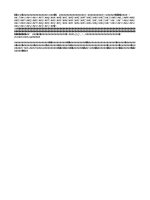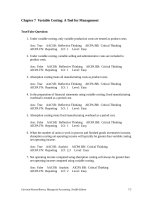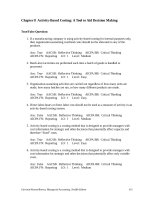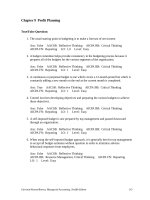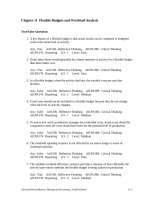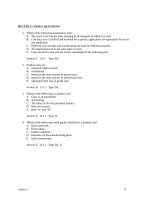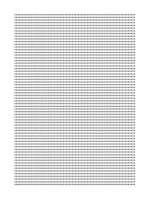Test bank managerial accounting by hilton 9e chapter11
Bạn đang xem bản rút gọn của tài liệu. Xem và tải ngay bản đầy đủ của tài liệu tại đây (168.64 KB, 39 trang )
MULTIPLE CHOICE QUESTIONS
1. A static budget:
A. is based totally on prior year's costs.
B. is based on one anticipated activity level.
C. is based on a range of activity.
D. is preferred over a flexible budget in the evaluation of performance.
E. presents a clear measure of performance when planned activity differs from actual
activity.
Answer: B LO: 1 Type: RC
2. Flexible budgets reflect a company's anticipated costs based on variations in:
A. activity levels.
B. inflation rates.
C. managers.
D. anticipated capital acquisitions.
E. standards.
Answer: A LO: 1 Type: RC
3. A flexible budget:
A. parallels a static budget with respect to format and advantages of use.
B. is preferred over a static budget in the evaluation of performance.
C. gives management flexibility in terms of meeting budget goals.
D. can be used to compare actual and budgeted costs at various levels of activity.
E. is characterized by choices "B" and "D" above.
Answer: E LO: 1 Type: RC
4. Interstate Merchandising anticipated selling 29,000 units of a major product and paying sales
commissions of $6 per unit. Actual sales and sales commissions totaled 31,500 units and
$182,700, respectively. If the company used a static budget for performance evaluations,
Interstate would report a cost variance of:
A. $6,300U.
B. $6,300F.
C. $8,700U.
D. $8,700F.
E. some other amount not listed above.
Answer: C LO: 1 Type: A
Chapter 11
47
5. Main Street Merchandising anticipated selling 24,000 units of a major product and paying
sales commissions of $5 per unit. Actual sales and sales commissions totaled 23,600 units and
$120,360, respectively. If the company used a flexible budget for performance evaluations,
Main Street would report a cost variance of:
A. $360U.
B. $360F.
C. $2,360U.
D. $2,360F.
E. some other amount not listed above.
Answer: C LO: 1 Type: A
6. Badger Bakeries anticipated making 17,000 fancy cakes during a recent
period, requiring 14,000 hours of process time. Each hour of process time
was expected to cost the firm $11. Actual activity for the period was
higher than anticipated: 18,000 cakes and 15,200 hours. If each hour of
process time actually cost Badger $12, what process-time variance would
be disclosed on a performance report that incorporated static budgets and
flexible budgets?
Static
Flexible
A. $15,200U
$15,200
U
B. $15,200U
$28,400U
C. $28,400U
$15,200
U
D. $28,400U
$28,400U
E. None of the above
Answer: C LO: 1 Type: A
7. Lantern Corporation recently prepared a manufacturing cost budget for an output of 50,000
units, as follows:
Direct materials
Direct labor
Variable overhead
Fixed overhead
$100,000
50,000
75,000
100,000
Actual units produced amounted to 60,000. Actual costs incurred were: direct materials,
$110,000; direct labor, $60,000; variable overhead, $100,000; and fixed overhead, $97,000. If
Lantern evaluated performance by the use of a flexible budget, a performance report would
reveal a total variance of:
A. $3,000 favorable.
B. $23,000 favorable.
C. $27,000 unfavorable.
D. $42,000 unfavorable.
E. none of the above amounts.
48
Hilton, Managerial Accounting, Seventh Edition
Answer: A LO: 1, 2 Type: A
Chapter 11
49
8. Zin, Inc., is planning its cash needs for an upcoming period when 85,000 machine hours are
expected to be worked. Activity may drop as low as 78,000 hours if some overdue equipment
maintenance procedures are performed; on the other hand, activity could jump to 94,000 hours
if one of Zin's major competitors likely goes bankrupt. A flexible cash budget to determine
cash needs would best be based on:
A. 78,000 hours.
B. 85,000 hours.
C. 94,000 hours.
D. 78,000 hours and 94,000 hours.
E. 78,000 hours, 85,000 hours, and 94,000 hours.
Answer: E LO: 2 Type: N
9. Young Corporation has a high probability of operating at 40,000 activity hours during the
upcoming period, and lower probabilities of operating at 30,000 hours and 50,000 hours. The
company's flexible budget revealed the following:
Variable costs
Fixed costs
30,000 Hours
$135,000
720,000
40,000 Hours
$180,000
720,000
50,000 Hours
$225,000
720,000
Young's flexible-budget formula, where Y is defined as total cost and AH represents activity
hours, is:
A. Y = $4.50AH + $24AH.
B. Y = $4.50AH + $720,000.
C. Y = $22.50AH.
D. Y = $180,000 + $18AH.
E. Y = $945,000.
Answer: B LO: 2 Type: A
10. Gourmet Restaurants has the following flexible-budget formula:
Y = $13PH + $450,000 where PH is defined as process hours
Which of the following statements is (are) true?
A. Gourmet has $450,000 of fixed costs.
B. Each additional hour of process time is expected to cost Gourmet $13.
C. Y would equal the amount shown as "total cost" in the firm's flexible budget.
D. Choices "A" and "B" are true.
E. Choices "A," "B," and "C" are true.
Answer: E LO: 2 Type: N
50
Hilton, Managerial Accounting, Seventh Edition
11. Delicious Treats (DT) anticipated that 84,000 process hours would be worked during an
upcoming accounting period when, in fact, 92,000 hours were actually worked. One of the
company’s cost functions is expressed as follows:
Y = $16PH + $640,000 where PH is defined as process hours
What budgeted dollar amount would appear in DT’s static budget and flexible budget for the
preceding cost function?
Static
Flexible
A. $1,984,00
$1,984,000
0
B. $1,984,00
$2,112,000
0
C. $2,112,000
$1,984,000
D. $2,112,000
$2,112,000
E. None of the above.
Answer: B LO: 2 Type: A, N
12. Which of the following mathematical expressions is found in a typical flexible-budget formula
for overhead?
A. Total activity units + budgeted fixed overhead cost per unit.
B. Budgeted variable overhead cost per unit + budgeted fixed overhead cost.
C. (Budgeted variable overhead cost per unit x total activity units) + budgeted fixed
overhead costs.
D. (Budgeted fixed overhead cost per unit x total activity units) + (budgeted variable
overhead cost per unit x total activity units).
E. None of the above.
Answer: C LO: 2 Type: RC
13. A flexible budget for 15,000 hours revealed variable manufacturing overhead of $90,000 and
fixed manufacturing overhead of $120,000. The budget for 25,000 hours would reveal total
overhead costs of:
A. $210,000.
B. $270,000.
C. $290,000.
D. $350,000.
E. some other amount.
Answer: B LO: 2 Type: A
14. A flexible budget is appropriate for a(n):
Direct Labor
Marketing
Administrative
Budget
Budget
Expense Budget
A.
No
No
No
B.
No
Yes
Yes
C.
Yes
No
Yes
D.
Yes
Yes
Yes
Chapter 11
51
E.
No
No
Yes
Answer: D LO: 2 Type: N
52
Hilton, Managerial Accounting, Seventh Edition
15. A flexible budget is appropriate for a:
A.
B.
C.
D.
E.
Sales Commission
Budget
Yes
Yes
No
No
No
Direct Material
Budget
No
Yes
Yes
No
Yes
Variable Overhead
Budget
Yes
Yes
No
No
Yes
Answer: B LO: 2 Type: N
16. The manufacturing overhead applied to Work-in-Process Inventory by a company that uses
standard costing would be computed as:
A. actual hours x a predetermined (standard) overhead rate.
B. standard hours x a predetermined (standard) overhead rate.
C. actual hours x an actual overhead rate.
D. standard hours x an actual overhead rate.
E. $0, as these firms do not apply overhead to work in process.
Answer: B LO: 3 Type: RC
17. With respect to overhead, what is the difference between normal costing and standard costing?
A. Use of a predetermined overhead rate.
B. Use of standard hours versus actual hours.
C. Use of a standard rate versus an actual rate.
D. The choice of an activity measure.
E. There is no difference.
Answer: B LO: 3 Type: RC
18. The activity measure selected for use in a variable- and fixed-overhead flexible budget:
A. should be stated in sales dollars.
B. should be approved by the company's president.
C. should vary in a similar behavior pattern to the way that variable overhead varies.
D. should remain fixed.
E. should produce the most attractive results for the individual who will use the budget in
managerial applications.
Answer: C LO: 4 Type: RC
19. Which of the following should have the strongest cause and effect relationship with overhead
costs?
A. Cost followers.
B. Non-value-added costs.
C. Cost drivers.
D. Value-added costs.
E. Units of output.
Chapter 11
53
Answer: C LO: 4 Type: RC
54
Hilton, Managerial Accounting, Seventh Edition
20. Which of the following is not an overhead variance?
A. Variable-overhead spending variance.
B. Variable-overhead volume variance.
C. Variable-overhead efficiency variance.
D. Fixed-overhead budget variance.
E. Fixed-overhead volume variance.
Answer: B LO: 5 Type: RC
21. Which of the following is not an overhead variance?
A. Variable-overhead spending variance.
B. Variable-overhead efficiency variance.
C. Fixed-overhead efficiency variance.
D. Fixed-overhead budget variance.
E. Fixed-overhead volume variance.
Answer: C LO: 5 Type: RC
22. Which of the following is used in the computation of the variable-overhead
spending variance?
Actual Variable
Budgeted Variable Overhead
Standard Variable
Overhead Cost
Based on Actual Hours
Overhead Applied
A.
No
Yes
No
B.
No
No
No
C.
Yes
No
Yes
D.
Yes
Yes
No
E.
Yes
Yes
Yes
Answer: D LO: 5 Type: RC
23. Which of the following elements are needed in a straightforward calculation of the variableoverhead spending variance?
A. Variable overhead incurred during the period.
B. Budgeted variable overhead based on actual hours worked.
C. Standard variable overhead applied to production.
D. Elements "A" and "B" above.
E. Elements "A" and "C" above.
Answer: D LO: 5 Type: RC
Chapter 11
55
24. Assume that machine hours is the cost driver for overhead. The difference between the actual
variable overhead incurred and the applied variable overhead is the:
A. volume variance.
B. net overhead variance.
C. efficiency variance.
D. sum of the spending and efficiency variances.
E. spending variance.
Answer: D LO: 5 Type: RC
25. What will cause the variable-overhead efficiency variance?
A. Efficient or inefficient use of a specific component of variable overhead (e.g., electricity).
B. Full or partial utilization of major equipment resources.
C. Production of units in excess of the number of units sold.
D. Efficient or inefficient use of the cost driver (e.g., machine hours) for variable overhead.
E. Changes in the salary cost of production supervisors.
Answer: D LO: 5 Type: N
26. Smithville uses labor hours to apply variable overhead to production. If the company's
workers were very inefficient during the period, which of the following statements would be
true about the variable-overhead efficiency variance?
A. The variance would be favorable.
B. The variance would be unfavorable.
C. The nature of the variance (favorable or unfavorable) would be unknown based on the
facts presented.
D. The variance would be the same amount as the labor efficiency variance.
E. None of the above.
Answer: B LO: 5 Type: N
27. The difference between the total actual factory overhead and the total factory overhead applied
to production is the:
A. sum of the spending, efficiency, budget, and volume variances.
B. controllable variance.
C. efficiency variance.
D. spending variance.
E. volume variance.
Answer: A LO: 5 Type: RC
56
Hilton, Managerial Accounting, Seventh Edition
28. Which of the following variances would be useful to help control overhead
spending?
Variable-Overhead
Fixed-Overhead
Fixed-Overhead
Spending Variance
Budget Variance
Volume Variance
A.
Yes
Yes
Yes
B.
Yes
Yes
No
C.
Yes
No
No
D.
Yes
No
Yes
E.
No
Yes
No
Answer: B LO: 5 Type: N
29. The budget variance arises from a comparison of:
A. budgeted fixed overhead expenditures with budgeted fixed overhead costs.
B. actual fixed overhead costs with budgeted fixed overhead costs.
C. actual variable overhead expenditures with budgeted variable overhead costs.
D. variable overhead costs with budgeted fixed overhead costs.
E. static-budget amounts with flexible-budget amounts.
Answer: B LO: 5 Type: RC
30. Which of the following is used in the computation of the fixed overhead
budget variance?
Actual Fixed
Budgeted Fixed
Fixed Overhead Applied to
Overhead
Overhead
Production
A.
Yes
Yes
Yes
B.
Yes
Yes
No
C.
Yes
No
Yes
D.
Yes
No
No
E.
No
Yes
Yes
Answer: B LO: 5 Type: RC
31. The difference between budgeted fixed manufacturing overhead and the fixed overhead
applied to production is the:
A. sum of the spending and efficiency variances.
B. controllable variance.
C. efficiency variance.
D. spending variance.
E. volume variance.
Answer: E LO: 5 Type: RC
32. A fixed-overhead volume variance would normally arise when:
A. actual hours of activity coincide with actual units of production.
B. budgeted fixed overhead is overapplied to production.
C. there is a fixed-overhead budget variance.
D. actual fixed overhead exceeds budgeted fixed overhead.
E. there is a variable-overhead efficiency variance.
Chapter 11
57
Answer: B LO: 5 Type: RC
58
Hilton, Managerial Accounting, Seventh Edition
33. Which variance is commonly associated with measuring the cost of under- or over-utilization
of plant capacity?
A. The variable-overhead spending variance.
B. The variable-overhead efficiency variance.
C. The fixed-overhead budget variance.
D. The fixed-overhead volume variance.
E. The total fixed-overhead variance.
Answer: D LO: 5 Type: RC
34. Rowe Corporation reported the following variances for the period just ended:
Variable-overhead spending variance: $50,000U
Variable-overhead efficiency variance: $28,000U
Fixed-overhead budget variance: $70,000U
Fixed-overhead volume variance: $30,000U
If Rowe desires to analyze variances that arose primarily from managers' expenditures in
excess of anticipated amounts, the company should focus on variances that total:
A. $50,000U.
B. $70,000U.
C. $120,000U.
D. $178,000U.
E. some other amount.
Answer: C LO: 5 Type: A, N
35. Delson Company, which applies overhead to production on the basis of machine hours,
reported the following data for the period just ended:
Actual units produced: 10,000
Actual variable overhead incurred: $62,000
Actual machine hours worked: 16,000
Standard variable overhead cost per machine hour: $4
If Delson estimates 1.7 hours to manufacture a completed unit, the company's variableoverhead spending variance is:
A. $2,000 favorable.
B. $2,000 unfavorable.
C. $6,000 favorable.
D. $6,000 unfavorable.
E. some other amount not listed above.
Answer: A LO: 5 Type: A
Chapter 11
59
36. Martin Company, which applies overhead to production on the basis of machine hours,
reported the following data for the period just ended:
Actual units produced: 9,000
Actual variable overhead incurred: $54,400
Actual machine hours worked: 16,000
Standard variable overhead cost per machine hour: $3.50
If Martin estimates two hours to manufacture a completed unit, the company's variableoverhead efficiency variance is:
A. $1,600 favorable.
B. $1,600 unfavorable.
C. $7,000 favorable.
D. $7,000 unfavorable.
E. some other amount not listed above.
Answer: C LO: 5 Type: A
Use the following to answer questions 37-38:
Abbott has a standard variable overhead rate of $4.50 per machine hour, and each unit produced has a
standard time allowed of three hours. The company's static budget was based on 46,000 units. Actual
results for the year follow.
Actual units produced: 42,000
Actual machine hours worked: 120,000
Actual variable overhead incurred: $520,000
37. Abbott's variable-overhead spending variance is:
A. $20,000 favorable.
B. $20,000 unfavorable.
C. $27,000 favorable.
D. $27,000 unfavorable.
E. not listed above.
Answer: A LO: 5 Type: A
38. Abbott's variable-overhead efficiency variance is:
A. $20,000 favorable.
B. $20,000 unfavorable.
C. $27,000 favorable.
D. $27,000 unfavorable.
E. not listed above.
Answer: C LO: 5 Type: A
60
Hilton, Managerial Accounting, Seventh Edition
39. Arling Company, which applies overhead to production on the basis of machine hours,
reported the following data for the period just ended:
Actual units produced: 12,000
Actual fixed overhead incurred: $730,000
Actual machine hours worked: 60,000
Budgeted fixed overhead: $720,000
Planned level of machine-hour activity: 50,000
If Arling estimates four hours to manufacture a completed unit, the company's standard fixed
overhead rate per machine hour would be:
A. $12.00.
B. $14.40.
C. $14.60.
D. $15.00.
E. some other amount.
Answer: B LO: 5 Type: A
40. Herman Company, which applies overhead to production on the basis of machine hours,
reported the following data for the period just ended:
Actual units produced: 13,000
Actual fixed overhead incurred: $742,000
Standard fixed overhead rate: $15 per hour
Budgeted fixed overhead: $720,000
Planned level of machine-hour activity: 48,000
If Herman estimates four hours to manufacture a completed unit, the company's fixedoverhead budget variance would be:
A. $22,000 favorable.
B. $22,000 unfavorable.
C. $60,000 favorable.
D. $60,000 unfavorable.
E. some other amount.
Answer: B LO: 5 Type: A
Chapter 11
61
41. Enberg Company, which applies overhead to production on the basis of machine hours,
reported the following data for the period just ended:
Actual units produced: 14,800
Actual fixed overhead incurred: $791,000
Standard fixed overhead rate: $13 per hour
Budgeted fixed overhead: $780,000
Planned level of machine-hour activity: 60,000
If Enberg estimates four hours to manufacture a completed unit, the company's fixed-overhead
volume variance would be:
A. $10,400 favorable.
B. $10,400 unfavorable.
C. $11,000 favorable.
D. $11,000 unfavorable.
E. some other amount.
Answer: B LO: 5 Type: A
Use the following to answer questions 42-43:
Benson Company, which uses a standard cost system, budgeted $600,000 of fixed overhead when
40,000 machine hours were anticipated. Other data for the period were:
Actual units produced: 10,000
Standard production time per unit: 3.9 machine hours
Fixed overhead incurred: $620,000
Actual machine hours worked: 42,000
42. Benson's fixed-overhead budget variance is:
A. $10,000 favorable.
B. $15,000 favorable.
C. $15,000 unfavorable.
D. $20,000 favorable.
E. $20,000 unfavorable.
Answer: E LO: 5 Type: A
43. Benson's fixed-overhead volume variance is:
A. $10,000 favorable.
B. $15,000 favorable.
C. $15,000 unfavorable.
D. $20,000 favorable.
E. $20,000 unfavorable.
Answer: C LO: 5 Type: A
62
Hilton, Managerial Accounting, Seventh Edition
Use the following to answer questions 44-46:
Sussex Company uses a standard cost system and prepared the following budget for May when 24,000
machine hours of activity were anticipated: variable overhead, $48,000; fixed overhead: $240,000.
Actual data for May were:
Standard machine hours allowed for output attained: 25,000
Actual machine hours worked: 24,000
Variable overhead incurred: $50,000
Fixed overhead incurred: $250,000
44. The standard variable overhead rate for May is:
A. $2.00.
B. $2.08.
C. $3.00.
D. $5.00.
E. $5.21.
Answer: A LO: 5 Type: A
45. The variable-overhead
Variable-Overhead
Spending Variance
A. $0
B. $0
C. $2,000 unfavorable
D. $2,000 favorable
E. $2,000 unfavorable
spending and efficiency variances are:
Variable-Overhead
Efficiency Variance
$0
$2,000 unfavorable
$0
$2,000 unfavorable
$2,000 favorable
Answer: E LO: 5 Type: A
46. The fixed-overhead budget and volume variances are:
Fixed-Overhead
Fixed-Overhead
Budget Variance
Volume Variance
A. $0
$10,000 favorable
B. $10,000 favorable
$0
C. $10,000 favorable
$10,000 unfavorable
D. $10,000 unfavorable
$0
E. $10,000 unfavorable
$10,000 favorable
Answer: E LO: 5 Type: A
Chapter 11
63
Use the following to answer questions 47-51:
Duncanville, Inc., has the following overhead standards:
Variable overhead: 4 hours at $8 per hour
Fixed overhead: 4 hours at $10 per hour
The standards were based on a planned activity of 20,000 machine hours when 5,000 units were
scheduled for production. Actual data follow.
Variable overhead incurred: $167,750
Fixed overhead incurred: $210,000
Machine hours worked: 19,800
Actual units produced: 5,100
47. Duncanville's fixed-overhead budget variance is:
A. $6,000 unfavorable.
B. $7,000 unfavorable.
C. $10,000 unfavorable.
D. $12,000 unfavorable.
E. not listed above.
Answer: C LO: 5 Type: A
48. Duncanville's fixed-overhead volume variance is:
A. $4,000 favorable.
B. $4,000 unfavorable.
C. $10,000 favorable.
D. $10,000 unfavorable.
E. not listed above.
Answer: A LO: 5 Type: A
49. Duncanville's variable-overhead spending variance is:
A. $550 favorable.
B. $4,550 unfavorable.
C. $4,800 favorable.
D. $9,350 unfavorable.
E. not listed above.
Answer: D LO: 5 Type: A
50. Duncanville's variable-overhead efficiency variance is:
A. $550 favorable.
B. $550 unfavorable.
C. $4,800 favorable.
D. $4,800 unfavorable.
E. not listed above.
64
Hilton, Managerial Accounting, Seventh Edition
Answer: C LO: 5 Type: A
Chapter 11
65
51. The amount of variable overhead that Duncanville applied to production is:
A. $158,400.
B. $160,000.
C. $163,200.
D. $167,750.
E. not listed above.
Answer: C LO: 5 Type: A
52. Luke, Inc., has a standard variable overhead rate of $5 per machine hour, with each completed
unit expected to take three machine hours to produce. A review of the company's accounting
records found the following:
Actual production: 19,500 units
Variable-overhead efficiency variance: $9,000U
Variable-overhead spending variance: $21,000F
What was Luke's actual variable overhead during the period?
A. $262,500.
B. $280,500.
C. $304,500.
D. $322,500.
E. Some other amount.
Answer: B LO: 5 Type: A, N
53. Bushnell, Inc., has a standard variable overhead rate of $4 per machine hour, with each
completed unit expected to take three machine hours to produce. A review of the company's
accounting records found the following:
Actual variable overhead: $210,000
Variable-overhead efficiency variance: $18,000U
Variable-overhead spending variance: $30,000F
How many units did Bushnell actually produce during the period?
A. 13,500.
B. 16,500.
C. 18,500.
D. 21,500.
E. Some other amount.
Answer: C LO: 5 Type: A, N
66
Hilton, Managerial Accounting, Seventh Edition
54. Atlanta Enterprises incurred $828,000 of fixed overhead during the period. During that same
period, the company applied $845,000 of fixed overhead to production and reported an
unfavorable budget variance of $41,000. How much was Atlanta's budgeted fixed overhead?
A. $787,000.
B. $804,000.
C. $869,000.
D. $886,000.
E. Not enough information to judge.
Answer: A LO: 5 Type: A, N
Use the following to answer questions 55-56:
SanBox Company is choosing new cost drivers for its accounting system. One driver is labor hours;
the other is a combination of machine hours for unit variable costs and number of setups for a pool of
batch-level costs. Data for the past year follow.
Labor hours
Machine hours
Number of setups
Unit variable cost pool
Batch-level cost pool
Budget
200,000
360,000
3,000
$1,600,000
$900,000
Actual
200,000
450,000
3,300
$2,000,000
$990,000
55. Assume that both cost pools are combined into a single pool, and labor
hours is the driver. The total flexible budget for the actual level of labor
hours and the total variance for the combined pool are:
Flexible Budget
Variance
A.
$1,600,000
$400,000U
B.
$2,500,000
$490,000U
C.
$2,590,000
$400,000U
D.
$2,900,000
$90,000U
E.
$2,990,000
$0
Answer: B LO: 7 Type: A
56. Assume that the two separate pools are used. The flexible budget
amounts for the actual level of machine hours and actual number of setups
are:
Unit Variable
Batch-Level
Cost Pool
Cost Pool
A.
$1,600,000
$900,000
B.
$1,600,000
$990,000
C.
$2,000,000
$900,000
D.
$2,000,000
$990,000
E.
$2,500,000
$0
Answer: D LO: 7 Type: A
Chapter 11
67
57. What is the most common treatment of the fixed-overhead budget variance at the end of the
accounting period?
A. Reported as a deferred charge or credit.
B. Allocated among Work-in-Process Inventory, Finished-Goods Inventory, and Cost of
Goods Sold.
C. Charged or credited to Cost of Goods Sold.
D. Allocated among Cost of Goods Manufactured, Finished-Goods Inventory, and Cost of
Goods Sold.
E. Charged or credited to Income Summary.
Answer: C LO: 8 Type: RC
58. In an effort to reduce record-keeping procedure, companies that sell perishable goods will
often enter the standard cost of direct material, direct labor, and manufacturing overhead
directly into what account?
A. Work-in-Process Inventory.
B. Finished-Goods Inventory.
C. Cost of Goods Sold.
D. Cost of Goods Manufactured.
E. Sales Revenue.
Answer: C LO: 8 Type: RC
59. When actual variable cost per unit equals standard variable cost per unit, the difference
between actual and budgeted contribution margin is explained by a combination of which two
variances?
A. The sales-volume variance and the fixed-overhead volume variance.
B. The sales-volume variance and the fixed-overhead budget variance.
C. The sales-price variance and the fixed-overhead volume variance.
D. The sales-price variance and sales-volume variance.
E. The sales-price variance and fixed-overhead budget variance.
Answer: D LO: 9 Type: RC
60. The sales-volume variance equals:
A. (actual sales volume - budgeted sales volume) x actual sales price.
B. (actual sales volume - budgeted sales volume) x actual contribution margin.
C. (actual sales volume - budgeted sales volume) x budgeted sales price.
D. (actual sales price - budgeted sales price) x budgeted sales volume.
E. (actual sales price - budgeted sales price) x fixed-overhead volume variance.
Answer: C LO: 9 Type: RC
68
Hilton, Managerial Accounting, Seventh Edition
Use the following to answer questions 61-62:
Master Products has the following information for the year just ended:
Sales in units
Sales
Less: Variable expenses
Contribution margin
Less: Fixed expenses
Operating income
Budget
15,000
$150,000
90,000
$ 60,000
35,000
$ 25,000
Actual
14,000
$147,000
82,600
$ 64,400
40,000
$ 24,400
61. The company's sales-volume variance is:
A. $3,000 unfavorable.
B. $4,000 unfavorable.
C. $4,400 favorable.
D. $10,000 unfavorable.
E. $10,000 favorable.
Answer: D LO: 9 Type: A
62. The company's sales-price variance is:
A. $3,000 unfavorable.
B. $7,000 unfavorable.
C. $7,000 favorable.
D. $7,500 unfavorable.
E. $7,500 favorable.
Answer: C LO: 9 Type: A
Chapter 11
69
EXERCISES
Static Budget vs. Flexible Budget
63. Bavaria's budget for variable overhead and fixed overhead revealed the following information
for an anticipated 40,000 hours of activity: variable overhead, $348,000; fixed overhead,
$600,000.
The company actually worked 43,000 hours, and actual overhead incurred was: variable,
$365,500; fixed, $608,000.
Required:
A. Compute the company's total cost variance for variable overhead and fixed overhead if the
firm uses a static budget to help assess performance.
B. Repeat part "A" assuming the use of a flexible budget.
C. Which of the two budgets (static or flexible) is preferred for performance evaluations?
Why?
LO: 1, 2 Type: A, N
Answer:
A. Actual ($365,500 + $608,000)
Less: Static budget ($348,000 + $600,000)
Variance, unfavorable
B.
$973,500
948,000
$ 25,500
Budgeted variable overhead: $348,000 ÷ 40,000 hours = $8.70 per hour
Flexible budget [(43,000 hours x $8.70) + $600,000]
Less: Actual ($365,500 + $608,000)
Variance, favorable
C.
70
$974,100
973,500
$
600
Flexible budgets are preferred in performance evaluations. The use of
flexible budgets eliminates volume differences between actual and budgeted
activity, allowing the analyst to concentrate on differences between actual
and budgeted costs "on the same, level playing field." The result is a clearer
picture to study.
Hilton, Managerial Accounting, Seventh Edition
Flexible Budgets
64. The Houston Chamber Orchestra presents a series of concerts throughout the year. Budgeted
fixed costs total $300,000 for the concert season; variable costs are expected to average $5 per
patron. The orchestra uses flexible budgeting.
Required:
A. Prepare a flexible budget that shows the expected costs of 8,000, 8,500, and 9,000 patrons.
B. Construct the orchestra's flexible budget formula.
C. Assume that 8,700 patrons attended concerts during the year just ended, and actual costs
were: variable, $42,000; fixed, $307,500. Evaluate the orchestra's financial performance
by computing variances for variable costs and fixed costs.
LO: 1, 2 Type: A
Answer:
A. Patrons
Variable cost at $5
Fixed cost
Total
B.
8,000
$ 40,000
300,000
$340,000
8,500
$ 42,500
300,000
$342,500
9,000
$ 45,000
300,000
$345,000
Total budgeted cost = (number of patrons x $5) + $300,000
C.
Variable cost
Fixed cost
Total
Budget*
$ 43,500
300,000
$343,500
Actual
$ 42,000
307,500
$349,500
Variance
$1,500F
7,500U
$6,000U
*Variable budget: 8,700 patrons x $5
The variances reveal that the orchestra exceeded its budget for 8,700 patrons by
$6,000. The overall performance was not that bad, however, as the variances
(individually and in total) are small in both dollar- and percentage-terms.
Chapter 11
71
